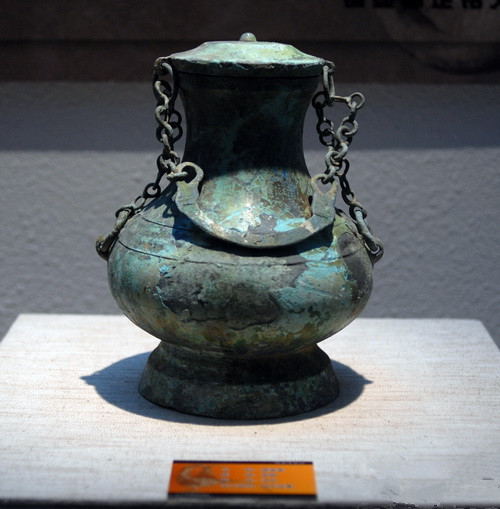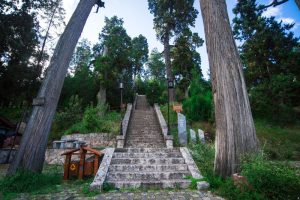Heimajing Tomb of Han Dynasty in Gejiu City, Honghe
The Heimajing Tomb (黑蚂井汉墓) is located atop the West Laodong Slope in Heimajing Village (黑蚂井村), Kafang Town (卡房镇), Gejiu City (个旧市), Honghe Prefecture (红河州). Positioned over 30 kilometers from the city center, the site encompasses more than 10,000 square meters, with the burial area exceeding 5,000 square meters.
In recent years, the international rise in tin prices has motivated some mine owners to disregard national laws and encroach on the protected areas surrounding the Heimajing tombs for mining purposes. This has led to significant environmental degradation, posing a direct threat to the safety of the ancient tomb complex. Consequently, the Gejiu Municipal Committee (中共个旧市委) and the Gejiu City Government (个旧市政府) decided to conduct a fourth emergency excavation of the site. As excavation progressed, numerous bronze artifacts from the Eastern Han Dynasty (东汉) were discovered. The finding of Heimajing bronze artifacts is crucial for enhancing the research on the tin culture of Gejiu City and serves as evidence of the historical roots and continuity of tin culture in both Gejiu and the broader Southwest region of China.
Importance of the Unearthed Bronze Artifacts from Heimajing
The history of tin mining in Gejiu dates back to the late Spring and Autumn period (春秋) in the 5th century BC, approximately 2,500 years ago. Throughout this extensive timeline, the early development of tin mining occurred during the Spring and Autumn, Warring States (战国), and Qin-Han dynasties (秦汉), when significant tin production gained a substantial scale and influence. Notably, the Eastern Han historian and writer Ban Gu (班固) referenced tin mining in Ben Gu (贲古) and Wu Mountain (乌山) in his seminal work, Book of Han (《汉书》). This historical context indicates that the Heimajing area, specifically near the foot of Xingshan Longshu (新山龙树), was once a flourishing mining region.
The artifacts recovered include over 100 exquisite bronze utensils, weapons, coins, and iron triangular racks, which represent the transition between the Bronze Age and Iron Age. Noteworthy items, such as bronze figurine lamps from the 1990s and other artifacts like the Zhuque lamp (朱雀灯), teapot (提梁壶), and incense burner (聚宝盆香炉) found during this excavation, suggest that Heimajing served as a vital manufacturing center for the central government during that era. The tomb owner was likely an official involved in the supervisory aspects of production.
The region, historically under the jurisdiction of Yizhou Prefecture (益州郡), included Yongchang County (永昌县) and Ailao County (哀牢县), with Honghe Prefecture belonging to the Ailao Mountain (哀牢山) area. Under central governance, this area had a significant status, particularly in an era characterized by primitive transportation and economic conditions. The presence of such extensive casting workshops suggests that Heimajing played an important role in the early stages of industrial civilization in China and is recognized as one of the earliest centers of metallurgy.
Historical Origins of Heimajing Bronze Artifacts and Tin Culture
Tin culture represents a cultural phenomenon born out of tin production, creating a complex that embodies the industrial civilization, living environment, and spiritual life associated with tin mining, selection, and smelting processes. The excavation of the Heimajing Han Tomb supports the notion that Gejiu’s tin culture has deep historical roots. The craftsmanship in smelting and manufacturing techniques reached impressive levels, showcasing the apex of bronze culture.
During the Han Dynasty, a coin known as White Currency (白币) was minted, made from an alloy of silver and tin that circulated briefly. The surface of the bronze mirror discovered during this excavation contains chromium components that remain lustrous even after over 2,000 years, indicating that our ancestors not only mastered bronze alloy casting but also created silver-tin and nickel-chromium alloys. Analysis of the chemical compositions of numerous bronze artifacts reveals they were manufactured using suitable amounts of tin, and since substantial tin deposits were primarily found in Gejiu, it is likely that the tin used in bronze artifacts sourced from this region. Thus, Gejiu can be identified as the origin of “tin culture,” embodying the spirit of bronze culture. Today, tin culture continues to shape China’s industrial trajectory, and the longstanding tin tradition has established Gejiu as the famous “Tin Capital” (锡都).
Cultural Intersection of Tin Culture
Tin culture results from the fusion between Central Plains culture (中原文化) and border culture (边地文化). The Han culture (汉族文化) from the Central Plains and minority cultures from border areas have blended over time to form a cohesive identity in Gejiu. Artifacts such as the copper figurine lamps unearthed from the 1980s, showcasing distinctive facial features and attire, along with various forms of oral literature and legends from the Yinxian (阴山) and Yangshan (阳山) areas, illustrate this cultural interaction between Han and minority cultures in this region.
A particularly representative example is the Tang Dynasty (唐代) Dongjing music, still prevalent in Datun (大屯), Kafang, and other locales. Without the rich history of tin culture, the Tang music would not have been able to endure in this area. The continuity of these cultural phenomena is sustained by multiple factors: the political system, as Gejiu was part of Yizhou Prefecture (益州郡) under central governance; trade routes, such as the Wuchidao (五尺道), a vital passage since the Qin Dynasty; and military interactions, as the Sichuan Basin was under the control of the Shu Kingdom during the Three Kingdoms period, with Zhuge Liang (诸葛亮) leading military efforts to stabilize the Southern regions (南中) and strategically overcoming local leader Meng Huo (孟获). These historical connections underscore Gejiu’s early cultural and military exchanges with the inland regions.
Integrating History and Economy
The challenge lies in how to merge historical significance with tourism to support the modern economy. The tourism economy, regarded as a form of low-carbon economic development, is characterized by minimal investment and rapid returns, exemplifying both social and economic benefits—commonly referred to as a smoke-free industry. Presently, there is ongoing development in Gejiu’s tourism sector, and while skepticism exists, there is potential for growth. The core focus of tourism development should center on tin culture.
Tourism relies on two main pillars: natural scenery and cultural heritage. The creation of these attractions represents the essence of tourism. Gejiu, with its perpetually spring-like climate and rich tin cultural heritage, must prioritize the development of tourism centered on tin culture.
Currently, the site of the Heimajing Han Tomb lacks adequate preservation conditions. It is proposed that the unearthed Han tombs be restored to the summit of Laoyin Mountain (老阴山) to establish a dedicated Han tomb tourism area, harmonizing with the existing Baohua Temple (宝华寺) upper courtyard, thus creating a unified tourism product that merges Buddhist culture with the heritage of ancient industrial civilization.
Furthermore, leveraging scenic attractions is essential for tourism growth. Gejiu should be positioned as a central hub, connecting to nearby county and city tourist sites—such as border tourism in Hekou (河口), sightseeing at the Yuanyang Hani Rice Terraces (元阳哈尼梯田), cultural exploration at the Jianshui Confucius Temple (建水孔庙), and historical visits to the Zhu Family Garden (朱家花园). Integrating these resources into Gejiu’s tourism strategy would invigorate the industry and foster a vibrant sector amid economic transformation.
How to Get There
To reach the Heimajing Tomb of Han Dynasty in Gejiu City, visitors can take a bus or drive from the Gejiu city center. The journey typically lasts around 30-40 minutes.
Travel Tips
- Best Time to Visit: The ideal time to explore the site is during spring and autumn, when the weather is mild and pleasant.
- Local Guides: Hiring a local guide can enhance your experience by providing deeper insights into the historical significance of the artifacts and the culture of the area.
- Respect Preservation: Visitors should be mindful of the site’s preservation efforts and avoid disturbing any excavated areas.
- Pack Essentials: It’s advisable to bring water, snacks, and sunscreen, especially if planning to explore the surrounding natural scenery.














